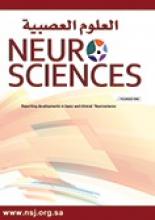To the Editor
We have read with interest the excellent case report on Hashimoto’s encephalopathy presenting with progressive cerebellar ataxia in a 25-year-old woman published in Neurosciences journal.1 Algahtani et al1 described a case of 2-month progressive, sporadic adult-onset cerebellar degeneration. Elevated anti-thyroid antibodies were found in the normal thyroid function test. Extensive investigations, including cerebrospinal fluid, genetic, and paraneoplastic tests, were unremarkable. Brain magnetic resonance imaging revealed symmetrical cerebellar atrophy. Treatment with pulse steroid therapy followed by oral prednisone administration did not improve the cerebellar signs. The trial of plasma exchange, followed by intravenous immunoglobulin administration, resulted in some improvement of the patient’s symptoms.
The authors suggested that ataxia associated with elevated anti-thyroid antibodies could be due to Hashimoto’s encephalopathy-related cerebellar degeneration. This association raises several important issues for the diagnosis and treatment of sporadic adult-onset cerebellar ataxia. I want to make 2 comments.
First, there is another clinical presentation of Hashimoto’s encephalopathy-associated cerebellar ataxia that includes acute to subacute cerebellar syndrome, encephalopathy, elevated cerebrospinal fluid protein, and dramatic clinical response to steroids, which is a strong indicator of an autoimmune process in the cerebellum.
Second, the prevalence of anti-thyroid antibodies in the general population is high (6.9–9.7% in women of reproductive age).2 Therefore, it is plausible that elevated anti-thyroid antibodies are coincidental findings. The presence of anti-thyroid antibodies can be associated with other autoimmune disorders. Therefore, the finding of anti-thyroid antibodies, in this case, could suggest the presence of another autoimmune disease, which is responsive to plasma exchange and intravenous immunoglobulin. Therefore, the use of the term “Hashimoto’s encephalopathy” may be inaccurate.
Reply from the Author
We have read with the correspondence of Dr. Yasir Almalik with interest and we really appreciate his comments. We did all work-up for the differential diagnoses and possible causes in our case with the only explanation found being Hashimot’s encephalopathy with progressive cerebellar ataxia. Our diagnosis should be accurate until another cause is found. Given the excellent response, long duration follow-up and lack of any clinical features suggesting an alternative diagnosis, the diagnosis in my opinion is still valid and convincing.
Hussein A. Algahtani,
King Abdulaziz Medical City, King Saud bin Abdulaziz University for Health Sciences, Jeddah, Kingdom of Saudi Arabia.
- Copyright: © Neurosciences
Neurosciences is an Open Access journal and articles published are distributed under the terms of the Creative Commons Attribution-NonCommercial License (CC BY-NC). Readers may copy, distribute, and display the work for non-commercial purposes with the proper citation of the original work.






